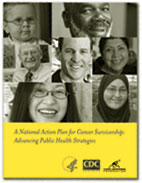|
|
||||||||||||||||
|
|
|
|
|
|||||||||||||
|
|
Control and Prevention Division of Cancer Prevention and Control 4770 Buford Hwy, NE MS K-64 Atlanta, GA 30341-3717 Call: 1 (800) CDC-INFO TTY: 1 (888) 232-6348 FAX: (770) 488-4760 E-mail: cdcinfo@cdc.gov Submit a Question Online |
|
|
|
National Action Plan for Cancer Survivorship

About the National Action PlanThe Centers for Disease Control and Prevention (CDC) and the Lance Armstrong Foundation (LAF) are leading a public health effort to address the issues faced by the growing number of cancer survivors living with, through, and beyond cancer. Through their collaboration, A National Action Plan for Cancer Survivorship: Advancing Public Health Strategies was developed. The National Action Plan represents the combined effort of almost 100 experts in cancer survivorship and public health. The National Action Plan identifies and prioritizes cancer survivorship needs and proposes strategies for addressing those needs within four core public health components:
The ProblemCancer is the second leading cause of death among adults in the United States and affects an estimated 1 in 3 individuals, either through their own diagnosis or that of a loved one.1 Recent innovations in medical technology have led to earlier diagnoses and better treatment of most cancers. As a result, more people diagnosed with cancer are living and surviving each year. Although many public health initiatives address early detection, prevention, and control of cancer, public health efforts to address cancer survivorship are relatively new. Survivors face numerous physical, psychological, social, spiritual, and financial issues at diagnosis, during treatment, and for the remaining years of their lives. Many of these issues could be successfully addressed through coordinated public health initiatives. Definition of Cancer SurvivorThe term "cancer survivors" refers to those people who have been diagnosed with cancer and the people in their lives who are affected by the diagnosis, including family members, friends, and caregivers. Purpose of the National Action PlanThe National Action Plan charts a course for how the public health community can more effectively and comprehensively address cancer survivorship and focus on improving the quality of life for survivors. This plan includes the following goals:
23 Recommended NeedsRecommended needs can be found in the "Survive Cancer and Live" brochure. (PDF-154KB) The following list includes five cross-cutting and 18 priority needs that were identified through the development process. Strategies for addressing these needs are detailed in the National Action Plan. Cross-cutting Needs
Priority Needs
National Action Plan Recommended StrategiesThe following list includes examples of proposed strategies for addressing survivorship needs.
Outcomes of the National Action PlanThe primary outcomes of this National Action Plan are expected to be greater awareness among the general public, policy makers, researchers, advocates, and survivors of the role public health can play in advancing cancer survivorship issues, and realizing the need to take action among organizations. Implementing proposed strategies can ultimately improve the overall experience and quality of life of the millions of Americans who are living with, through, and beyond cancer. A Public Health ApproachThe National Action Plan takes a comprehensive approach, focusing on the impact of cancer on the entire population and emphasizing collaborative, community-based activities. A public health approach includes influencing the health care system, providers, and policy makers that support and can make a difference in reducing the burden of cancer on survivors. With the release of the National Action Plan, CDC, LAF, and their partners are making a commitment to adopt a public health approach to cancer survivorship. This approach may address the numerous physical, psychological, social, spiritual, and financial issues that survivors face throughout their diagnosis, during treatment, and for the remaining years of their lives. Next StepsThis comprehensive approach is not easy. CDC, LAF, and their partners cannot possibly meet the challenges of cancer survivorship alone. The ambitious approaches outlined in this National Action Plan will be more easily implemented if public health organizations and individuals pursue coordinated strategies that are most applicable to their missions. Cancer survivors will greatly benefit from our collective and ongoing commitment of time, energy, and resources dedicated to preventing secondary diseases and improving quality of life. Given the importance of this health issue, its prevalence, its impact on quality of life, and the resulting costs to survivors and others in their lives, the time for action is now. Reference
Page last reviewed: October 27, 2007
Page last updated: March 5, 2007 Content source: Division of Cancer Prevention and Control, National Center for Chronic Disease Prevention and Health Promotion |
|
|||||||||||||||||||||||||||||||||||||||||||||||||||||||||||
|
|
|
||||||||||||
|